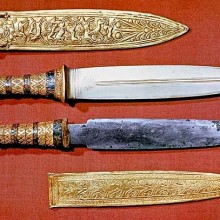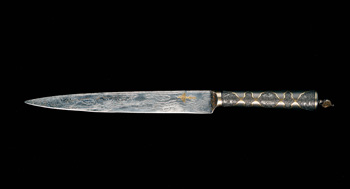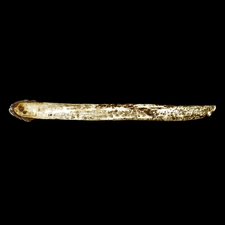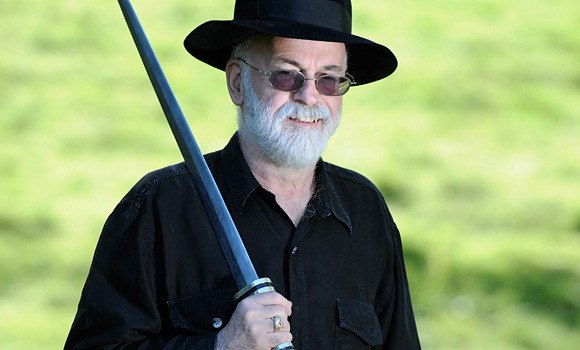Meteorite Weapons July 20, 2014
Author: Beach Combing | in : Contemporary, Medieval, Modern , trackback***Thanks to Radko for inspiring this post***
Imagine a blade made from a star. Now this is not actually as far fetched as it might first seem. After all, ‘stars’ (aka meteorites) sometimes fall to earth and some of them have enough iron content to make a blade practical. These blades are not necessarily exceptional: steel would win out every time. But still the exciting notion that you are carrying the beaten heavens around in your hands; or that you get to scalp or disembowel an enemy with something sent by God/the gods from a couple of light years away must thrill even the most jaded warrior.
There follow four meteorite blades. We would love to hear of some more meteorite weapons: drbeachcombing AT yahoo DOT com perhaps even a meteorite fire arm?
1) Ancient Egypt. Tutankhaman had two knives in his mummy. One was made of gold (top) and was not good for much. The other though was made of iron (bottom) and puzzled Egytologists for some time (they looked for a Hittite connection, as the Egyptians were not making iron at this date) until it was realised that the iron came from a meteorite. Tut liked the heavens and had a necklace made from a comet impact.
2) Early modern Indian knife. There is at the Smithsonian a gold/meteorite knife from among the Mughals. What is particularly interesting about this blade is that the meteorite from which it is made is reported as falling: the Emperor Jahangir ordered the knife to be created from the core of the meteorite. Note that at this date there was still a consensus in the west that ‘stones’ could not fall from the skies! If Jahangir had boasted about his find, then any ‘educated’ western visitor would have rolled their eyes.
3) Canadian lance. At some point in the eighteenth century an Inughuit made a lance from the remains of the Cape York meteorite, a blade that has come to rest in the British museum. The iron from the Cape York fall supplied much of Arctic America through much of the previous millennium: chunks and artifacts made from the Cape York falls had passed from hand to hand deep into what is today Canada. In a world without wood and where only bone could be used to cut, a meteorite weapon must have been quite something.
4) Terry Pratchett. There are several modern companies that make vanity knives (and watches and statues) from meteorite iron. But British fantasy writer, Terry Pratchett, went one further and forged a sword, which included meteorite iron (‘thunderbolt iron’), when he was knighted by the Queen in 2010. ‘With help from his friend Jake Keen — an expert on ancient metal-making techniques — the author dug up 81kg of ore and smelted it in the grounds of his house, using a makeshift kiln built from clay and hay and fuelled with damp sheep manure.’
There is a very doubtful fifth instance. According to rumour, and it would be interesting to see how far back this rumour could be traced (I’m guessing the 1990s), Jim Bowie’s famous Bowie knife was made of meteorite iron. This is impossible to demonstrate as no one is sure whether the original knife survives (there are several contenders). However, it seems inherently unlikely, not least because it is not clear that the knife was made before the existence of meteorites had been accepted by science in the very early nineteenth century. In other words, the forger would not have known to call it a meteorite.
Where does this prime bit of cobblers come from? Well, in part doubtless the desire to deify a great American hero, but also in part because Bowie’s knife maker, James Black, used to make his blades in an exceptionally secretive fashion. Who could resist slipping a story about meteoric iron through that gap?
PS A final thought. Were blades made from meteorite iron (a) because this was the only source of iron (e.g. the Inughuit) or (b) because there was the thrill of carrying around something that had fallen from the skies?
24 July 2014: JKM writes Indonesian Kris/Keris have in Dutch folklore been imbued with magical powers. One of the reasons for this is the legend that iron from the 1749 Prambanan meteorite was used in their manufacture. Such a kris need only be pointed at someone to kill. Unfortunately, this is only half true. Many late [19th C] krisses have been forged with a fraction of high-nickel meteoric iron.This was not primarily done for magical reasons, but to achieve a superior finish of the blade, after etching the blade with acid. The legend was created by the rather sad 19th c romantic Dr. Groneman, who passionately wanted to revive traditional krismaking, but ended a suicide. So real use of meteoric iron, but no magical powers. The entire story can be found here.’ Andy the Mad Monk, meanwhile, has actually made a meteorite hammer. ‘I too have made a small meteorite weapon. Attached is a picture of a copy of Mjölnir, Thor’s hammer I made for a man to give to his son for his 18th birthday. The hammerhead is carved and etched meteorite. Interestingly enough, the Widmanstätten patterns in meteorites can look like nordic runes.’ I’ll gladly put any potential customers in touch. Thanks guys!
Should also say that I’m hearing rumour about meteorite coins from Bactaria. I’ll get back to you on this if I find some documentation.
31 July 2014: The Astronomer from Space Between the Lines writes in with some welcome corrections: Normally, your posts are thoroughly researched. But I did catch a few errors in this one. As far as it can be determined, there are no known meteorites from “a couple of light years away”. All meteorites have their origins in our solar system. Most of them began their existence in the main asteroid belt (between Mars and Jupiter) and were spawned when their parent asteroids were struck by other asteroids. For example, three well-known varieties of stony meteorites, collectively known as HEDs (Howardites, Eucrites, and Diogenites) come from the asteroid Vesta and were most likely blasted off during the two large impacts in the southern part of the asteroid. A small handful of meteorites come from Mars. These were blasted off during impacts that took place at a specific angle allowing surface material to be accelerated to Martian escape velocity. These can be identified by their age (much younger than any asteroidal material) and composition. Some stony meteorites have come from the Moon, launched by a similar mechanism that launched the Martian meteorites. Lunar meteorites are identified by their composition, which is similar to the samples returned by the Apollo missions. The iron and nickel/iron meteorites mentioned in your post come from asteroids that were the remnants of larger planetesimals (the building blocks of planets) that had nickel/iron cores. As for the quality of the metal, it is not as bad as you seem to imply. While most modern steel is superior due to the introduction of carbon in the smelting process, meteoritic iron is pretty robust. Admiral Peary, who recovered the Anighito fragment of the Cape York meteorite fall (now exhibited in the Museum of Natural History in New York), likened the meteorite’s metal to the armor plate used on battleships of the time. And nickel/iron meteorites are notoriously difficult to cut open, even using modern equipment such as diamond-bladed saws. So, in the era when meteoritic weapons were somewhat popular, their iron was quite a bit superior to the early smelting efforts. It is entirely possible that meteoritic iron might have inspired the ancients to learn how to smelt iron from more plentiful iron ore. As for those bits of jewelry found in Egypt, they are made from what is known as impactite, which is sand that has been melted in the cosmic impact. It is also said that the Black Stone of the Kaaba in Mecca is a large piece of impactite. This is borne out by legends which claim the stone was originally honey-colored, but turned black over time. Impactite would turn black with weathering and excess handling.’ Thanks Stewart!
23 Jan 2016: Tod writes ‘traditionally kris in in the Malaysian and Indonesian islands incorporate meteoric iron recovered from the deserts of Australia and brought there on trade routes. It has a high nickel content and so makes for pretty laminations in the blades, but is actually rather soft, but when wiped over with a mixture of arsenic and orange juice and left in the sun, the steel goes black and the high nickel stays bright silver.’








